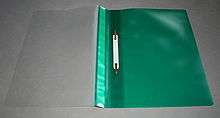Punched pocket

A punched pocket (UK English), polypocket[1] (UK English slang), slippery fish (UK English slang), sheet protector (US English), or sometimes perforated document bag is a flat, slitted plastic bag with a perforated edge used to hold paper documents, originally created in 1986 by Mike Townsend.
Physical characteristics
Punched pockets are usually transparent or semi-transparent, to allow viewing of the contents of a document without removing it. Color pockets are also available. They protect paper documents from tears, water, food, stains, and fingerprints, and partially prevent such documents from being crumpled. Punched pockets have several holes in the left edge, which allow them to be bound into a file, or a three-ring binder. The holes in the punched pockets dispose of the difficulty of making holes in a paper document.
The most commonly used material for punched pockets is polypropylene. However, there are some punched pockets made of polyethylene, cellophane, or other plastics. Punched pockets are made in several sizes, with the most prevalent being A4 for Europe, or 8.5" by 11" for the United States.
Usage

A punched pocket can contain only a small number of paper sheets. Often there is only one sheet per pocket. Sometimes a punched pocket contains two sheets, each with one-sided text outward.
One can see attached punched pockets, each containing a page with some information, in some banks, post offices and polyclinics. These pockets allow numerous visitors to read the information closely without soiling, deterioration, or accidental removal.